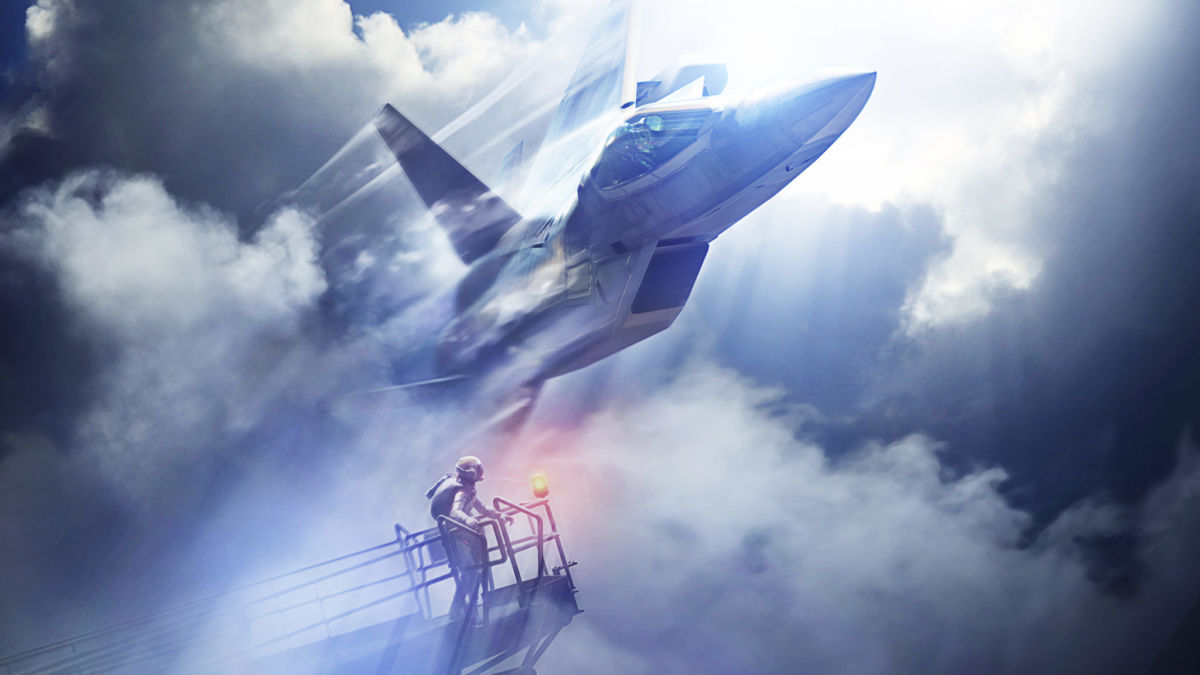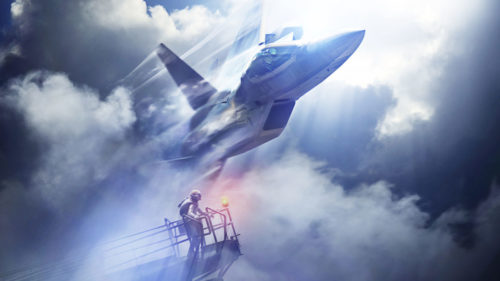
No video game has ever made me physically perspire to the degree Ace Combat has, ever since I played AC04 endlessly on my PS2 – it was the only game I had for a few months when I first received the console. The cutting-edge visuals, roaring and immersive sound and the rousing score all came together with tight, expertly designed flight combat to create some of my fondest controller-driven memories.
Ace Combat 7 did not disappoint in this regard – I’ve lost my grip on my analog sticks countless times in my initial playthrough. This game has everything series veterans have been waiting for since Ace Combat 6 way back in 2007, so if you’re a fellow fan on the fence or waiting for the PC release in a couple of weeks, know that you are in for a highly enjoyable experience and should not hesitate to pick up Ace Combat 7.
With that said, this game is not without its blemishes, especially in the story and the new gameplay mechanics. Before we dive too deep into all of that though, let’s get a little background for the uninitiated.
Ace Combat 6 technically was not the last game in the series before 7; we’ve had several others, including the rightfully-maligned Assault Horizon, which dropped the “Strangereal” setting of the series in favor of the real world. Since then, there hasn’t been a mainline single-player-focused entry in the series.
Strangereal is the now-official, previously fan-created nickname for the world of Ace Combat. It’s Earth, more or less, with a modern/near-future level of technology and a splash of anime/sci-fi influence for good measure. Nuclear weapons have been entirely removed from the picture after they were used in a scorched-earth maneuver by the country Belka in this world’s 1995. Instead, various superweapons populate the battlefields of Strangereal, many of them originally designed to shoot down an asteroid that ultimately still made planetfall in broken chunks. These impacts are the root cause of much of the geopolitical conflict and thus much of the warfare that the games center on.
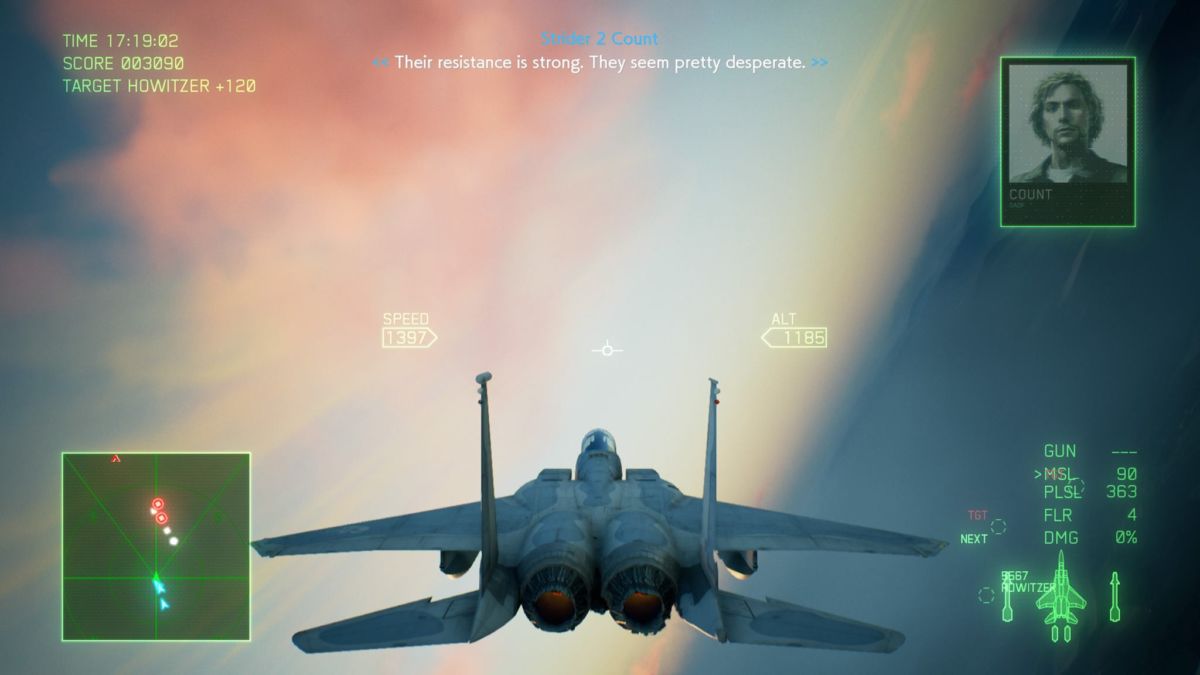
Ace Combat 7 dives head first right back into the complex lore and geopolitics of Strangereal – everything that happened in previous games is still canon, which means a great deal of baggage and history is there to work with. Set in 2019, on the long-suffering continent of Usea, the nation of Erusea declares war on just about everyone, swiftly capturing the majority of the continent by leveraging a massive fleet of drones, among other assets, including the Arsenal Bird drone carrier and the Space Elevator.
The 20-mission campaign sees the player character, a pilot from the country Osea callsign Trigger, take part in a wide range of scenarios during the war to retake Usea. Many of these scenarios will be familiar to series veterans: massive, multi-front battles against air, sea and land targets, massive furball dogfights with dozens of aircraft duking it out in the clouds, white-knuckle covert flights through canyons to avoid radar and searchlights, one-on-one duels with enemy ace pilots who can match and even surpass your every move, it’s all there. Plus, of course, the requisite tunnel flight. All of it is expertly crafted and finely tuned to create an ebb and flow of feeling drunk with power followed by moments of sheer terror and panic as the tides of battle are constantly turning.
A few missions, music tracks and dialogue references in particular evoke extremely strong memories and nostalgia, and it is clear that Project Aces wants to signal that they’re back to what they do best. It’s also clear that they have a glut of ideas in the 12 year gap, and it is the rush to implement so many of them that I believe hurts the game the most, especially in the story and the gameplay.
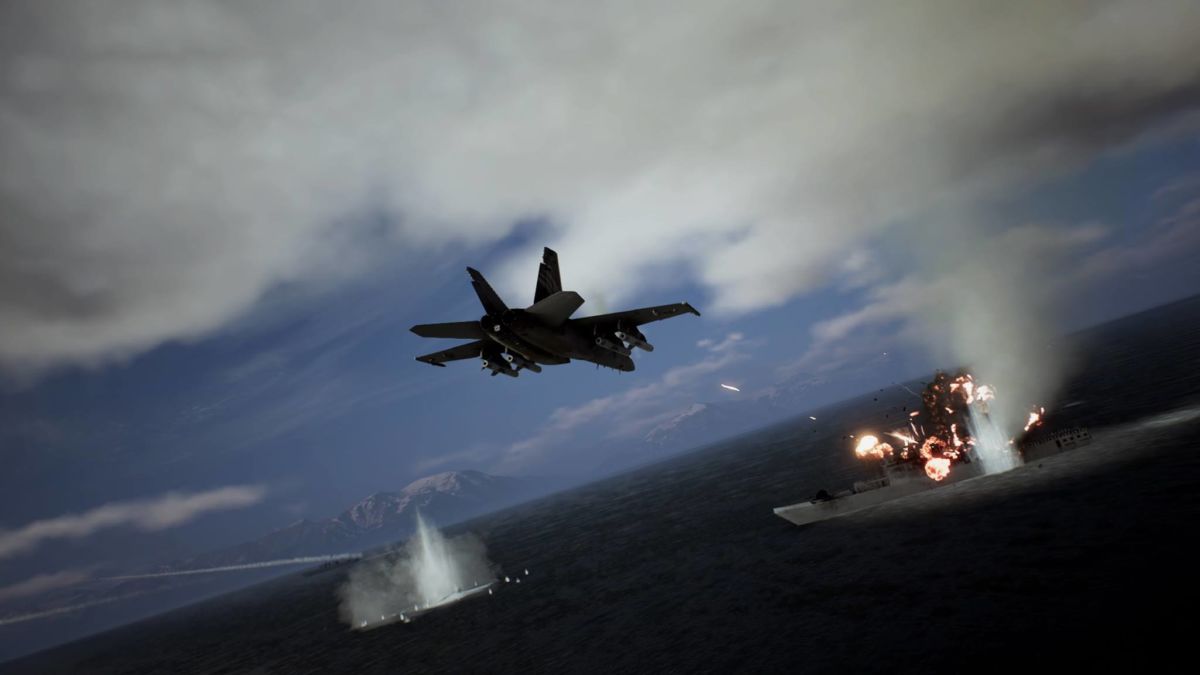
Though it was never the strongest part of the series, each game has always told a fairly contained story focusing on a core theme with a small amount of characters, usually on all sides of the conflict and told through an even split of cutscenes and in-mission events and dialogue. Here, it’s clear the team has a lot of ideas for their return to Strangereal, from the usual anti-war philosophizing to drones vs. human pilots, to over-reliance on technology and the very concept of borders and nations. One of these themes is fully realized and examined through gameplay and story (more on this shortly), while the rest either fall by the wayside or disappear entirely. None of the characters really stood out to me either, especially the wingmen, and the fact that there are several narrators hurts the already shoddy pacing.
New additions to gameplay focus mainly around weather. The much-touted feature has been clouds, which serve as concealment for both you and your enemies as well as aiding in evading missiles. The trade-off is not only in visibility, but also in the danger of your aircraft icing up, affecting performance and coating your canopy in a sheet of ice. This is a feature that acts as a throughline for the whole game, and you can always count on a cloud to have your back if they’re around. Unless it’s a storm cloud, of course.
Clouds are fine, fun even sometimes, and are an overall positive addition to the dynamic of the gameplay. The storm clouds on the other hand are gimmicky and frustrating, first showing up in a boss fight to add an unnecessary layer of frustration by striking you with lightning seemingly at random, frying your instruments temporarily and steering your plane towards the nearby ground or rock formation. The game never goes into the specific mechanics behind these clouds, your support aircraft just tells you to avoid them as the boss meanwhile hides in them to seemingly no ill-effect. This lack of NPC-affecting hazards is a larger problem that has admittedly existed in the series as a whole to an extent, but it’s become much more noticeable and disadvantageous to the player with this installment.
Air currents also pop up at just the right inopportune moments – seldom do they appear randomly during missions where the stakes are low enough that you can get some practice. It’s always in an already-stressful situation as your plane suddenly drifts right, left or up on its own rather violently. The game offers no help in figuring out how to counter this, and instead expects trial and error it seems. A couple of weather-based set pieces utilizing air currents and storms are actually enjoyable in their intensity, adding to the stakes impressed upon you by the context of the mission, but overall it feels like many of these weather features were thrown in without proper tuning and consideration; it would be great to see them improved and worked in more smoothly in the future. The addition of mid-mission checkpoints is perhaps the only thing that makes the trial-and-error gameplay bearable – you can recover from a failure and be back in action with refilled ammo and health inside of 10 seconds.
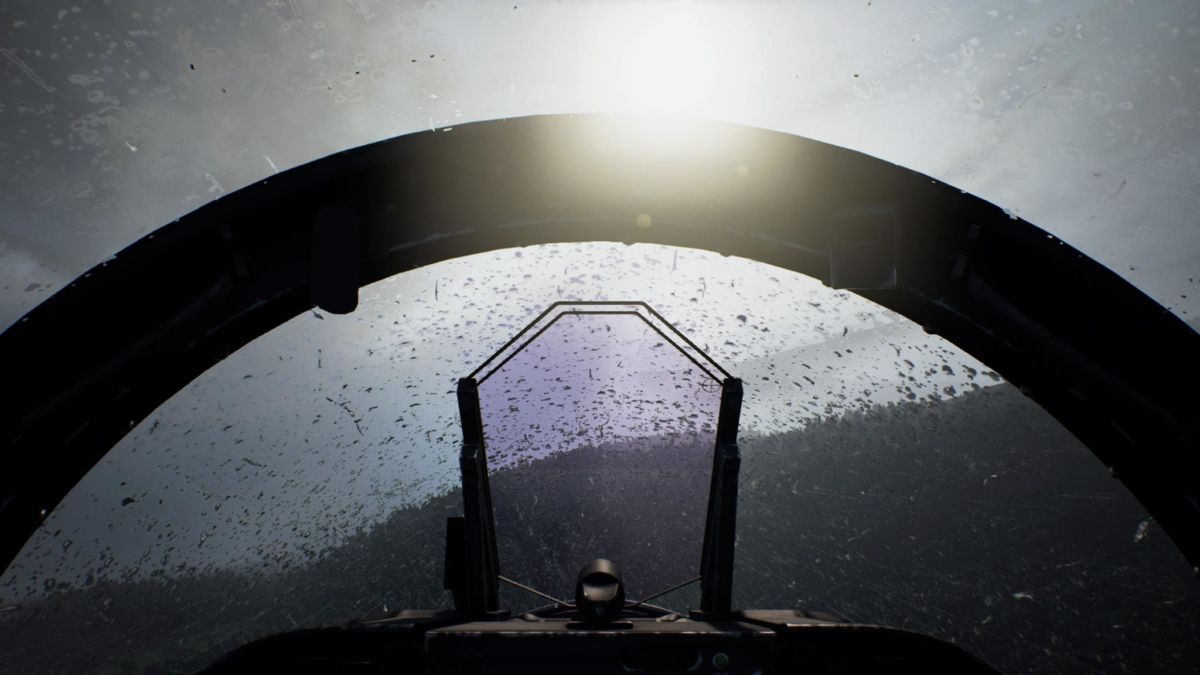
Gameplay-wise, there are a few “gimmicks” that are actually quite enjoyable, namely the times where you’re forced to hold fire or a wrench is otherwise thrown into the usual fire-at-will proceedings. One particular mission comes after a moment in the story where the theme of overreliance on technology really gets hammered home, resulting in every unit being labeled unknown on your HUD, including your allies, amid a multi-sided conflict in a dense cityscape while you are tasked with escorting a VIP. You can fire at anything, but if you do so before identifying your target, you might end up roasting an ally. This feature carries on for a few more missions, and it was a really cool way to shake things up – if there’s one thing Ace Combat can do, it’s make a fun escort mission. It would be nice if the game had done more with UI tricks and thematic integration like this and less with tossing my plane around like a frisbee.
Now, many of these issues with the weather and other systems and how they don’t affect other aircraft would be lessened significantly if it weren’t for the chief problem with Ace Combat 7 – with the removal of squad commands, this is without a doubt the most useless friendly AI in the series since at least AC04. Ace Combat has always been about framing the player character as a legendary ace in the making, bordering on a one-man air force, but beginning with AC5 the franchise introduced wingmen who could actually assist you in battle, beginning with simple commands like Cover Me and Engage At Will in 5 and Zero, to commanding an entire fighter wing to launch a volley of missiles at everything in front of you or pull you out of a tight spot in Ace Combat 6.
The vast majority of the mission was still on the player, but allowing the AI wingmen to assist and engage effectively really allowed for a more immersive war experience and for giving the player brief pauses to catch their breath or line up difficult shots on bosses or tricky hidden targets. With Trigger doing literally all of the work, you can bet your missile alert alarm will be going off constantly. The newly added flares, with their limited capacity and inconsistent usefulness, will not save you for long. Missions seem to have less time allotted overall as well compared to the old games, meaning you have less time to do more work with zero assistance even as your wingmen explicitly say they are covering you. It’s a shame too, because there’s a perfect point in the story where the commands could be introduced, much like the game continues to introduce weather and enemy types.

Speaking of too much stuff, this brings me to my final major issue with Ace Combat 7, the UI. To put it simply, the flight HUD has the worst color scheme possible. Allies are supposed to be blue boxes, enemies green, unknowns yellow and lock-on indicators and threat indicators are red. What happens instead is that the colors are so pale that, against any amount of cloud cover or light bloom, everything washes out and becomes the same sort of pale white color. This is easy enough to get around in some cases when you have time to look at your radar, but in the latter half of the game it becomes a frequent problem as the missions throw increasingly complex scenarios with multiple threat types and environmental obstacles at you – you can’t be glued to your radar when you’re trying to protect an ally and not smack your plane into a hill you can’t see through the fog. Additionally, the upgrade/plane purchase tree interface has some odd control issues, making it cumbersome to navigate at times, and it lacks a comparison function to examine two aircraft, weapons or upgrades side by side which is bizarre.
On the flip side, the new upgrade and points-based buying system are integrated wonderfully. Rather than a buying/selling economy like past games, where the money you earn based on mission performances and for selling your existing planes and weapons can be used to buy new ones, here you instead gain points to spend on a branching but ultimately linear set of planes, each with their own weapons to also purchase. They cannot be sold once obtained, which at first irked me as I looked at the prices of things later down the tree. This evaporated when I realized how many planes, weapons and upgrades I was using simply because I didn’t want the points to go to waste, and how much fun I was having doing it.
Upgrades are a new feature that allow you to slot in a limited amount of mods to your weapons, your plane’s maneuverability and miscellaneous special abilities. Most don’t have an overtly dramatic effect on gameplay, but you’ll start to notice the difference when targets go down easier, your missiles start hitting shots they’d previously miss and your plane begins to feel a lot more slippery when you’re evading your foes. It’s great fun speccing certain planes with certain upgrade loadouts, and it adds a great layer of complexity and customization to a gameplay formula that was going to need something new after so long. Plus, erasing an enemy fighter with a perfect railgun shot or strafing a runway with lasers never gets old.

This upgrade system ties into the rather bare-bones multiplayer, with points you gain from free-for-all or team matches usable across both the singleplayer and multiplayer-exclusive upgrade trees. Barebones does not mean it isn’t fun, but it does take a certain level of dedication and willingness to get your ass kicked for a bit to make it in multiplayer matches – deathmatch gets a lot more complicated when you bring the speed, maneuverability and lethality of fighter jets into the mix. I spent the vast majority of my play time with the campaign, and don’t have much more to say about the online portion other than that it is certainly a great test of skill and a steady way to earn points if you don’t feel like endlessly replaying campaign missions.
When you actually get these custom beauties out into the sky and start fighting, Ace Combat 7 is a veritable feast for the senses. Playing on a PlayStation 4 Pro, I experienced maybe two slight framerate slowdowns for a matter of seconds, but otherwise it ran flawlessly and never ceased to amaze me with something new every mission. From the chilling wail and oppressive darkness of a sandstorm to the hauntingly gorgeous sight of a smoking enemy fleet against the sunset, every single mission in Ace Combat 7 looks, sounds and just feels incredible. Weapons fire, engines, radio chatter and explosions all mix together in an impossible harmony to create one of the most unique warfare soundscapes out there – my only knock is that it sometimes drowns out Keiki Kobayashi’s immense original score. This seriously may be the man’s best work, period, but it is at times drowned out by all the chatter and explosions. I may have a grudge against the weather mechanics in gameplay, but there’s no denying that they made me awestruck the first time I saw them.
Ace Combat 7 is the first true Ace Combat game in 12 years, and despite some notable flaws, those flaws are the mark of a team trying new things while still retaining what fans love and what newcomers will be sure to embrace. No matter how hard it beats you down, it is impossible to stay mad at this game for very long. I know that I can’t wait to go back through again for higher score ratings, experiment with more planes and hunt down all of the hidden enemy Aces, just like the old days. Ace Combat is back, and its future is an exciting one.
Some of the coverage you find on Cultured Vultures contains affiliate links, which provide us with small commissions based on purchases made from visiting our site.
